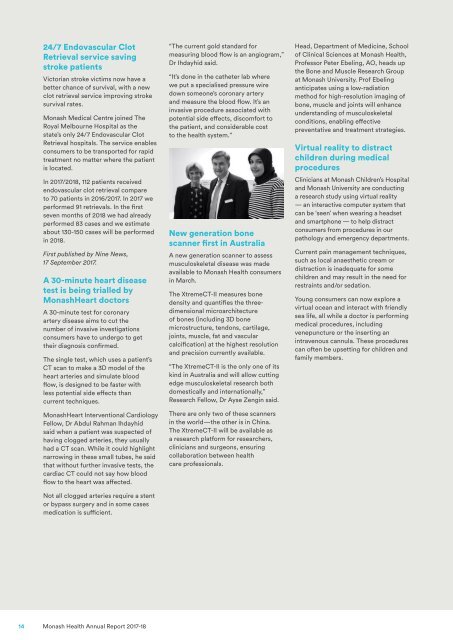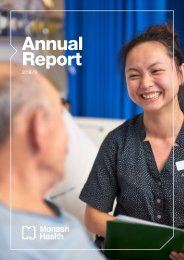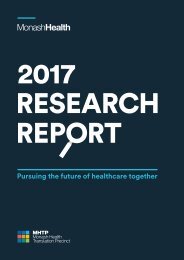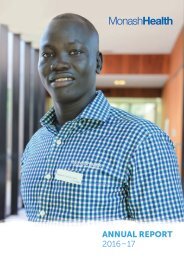Annual Report 2017-18 | Monash Health
Create successful ePaper yourself
Turn your PDF publications into a flip-book with our unique Google optimized e-Paper software.
24/7 Endovascular Clot<br />
Retrieval service saving<br />
stroke patients<br />
Victorian stroke victims now have a<br />
better chance of survival, with a new<br />
clot retrieval service improving stroke<br />
survival rates.<br />
<strong>Monash</strong> Medical Centre joined The<br />
Royal Melbourne Hospital as the<br />
state’s only 24/7 Endovascular Clot<br />
Retrieval hospitals. The service enables<br />
consumers to be transported for rapid<br />
treatment no matter where the patient<br />
is located.<br />
In <strong>2017</strong>/20<strong>18</strong>, 112 patients received<br />
endovascular clot retrieval compare<br />
to 70 patients in 2016/<strong>2017</strong>. In <strong>2017</strong> we<br />
performed 91 retrievals. In the first<br />
seven months of 20<strong>18</strong> we had already<br />
performed 83 cases and we estimate<br />
about 130-150 cases will be performed<br />
in 20<strong>18</strong>.<br />
First published by Nine News,<br />
17 September <strong>2017</strong>.<br />
A 30-minute heart disease<br />
test is being trialled by<br />
<strong>Monash</strong>Heart doctors<br />
A 30-minute test for coronary<br />
artery disease aims to cut the<br />
number of invasive investigations<br />
consumers have to undergo to get<br />
their diagnosis confirmed.<br />
The single test, which uses a patient’s<br />
CT scan to make a 3D model of the<br />
heart arteries and simulate blood<br />
flow, is designed to be faster with<br />
less potential side effects than<br />
current techniques.<br />
<strong>Monash</strong>Heart Interventional Cardiology<br />
Fellow, Dr Abdul Rahman Ihdayhid<br />
said when a patient was suspected of<br />
having clogged arteries, they usually<br />
had a CT scan. While it could highlight<br />
narrowing in these small tubes, he said<br />
that without further invasive tests, the<br />
cardiac CT could not say how blood<br />
flow to the heart was affected.<br />
Not all clogged arteries require a stent<br />
or bypass surgery and in some cases<br />
medication is sufficient.<br />
“The current gold standard for<br />
measuring blood flow is an angiogram,”<br />
Dr Ihdayhid said.<br />
“It’s done in the catheter lab where<br />
we put a specialised pressure wire<br />
down someone’s coronary artery<br />
and measure the blood flow. It’s an<br />
invasive procedure associated with<br />
potential side effects, discomfort to<br />
the patient, and considerable cost<br />
to the health system.”<br />
New generation bone<br />
scanner first in Australia<br />
A new generation scanner to assess<br />
musculoskeletal disease was made<br />
available to <strong>Monash</strong> <strong>Health</strong> consumers<br />
in March.<br />
The XtremeCT-II measures bone<br />
density and quantifies the threedimensional<br />
microarchitecture<br />
of bones (including 3D bone<br />
microstructure, tendons, cartilage,<br />
joints, muscle, fat and vascular<br />
calcification) at the highest resolution<br />
and precision currently available.<br />
“The XtremeCT-II is the only one of its<br />
kind in Australia and will allow cutting<br />
edge musculoskeletal research both<br />
domestically and internationally,”<br />
Research Fellow, Dr Ayse Zengin said.<br />
There are only two of these scanners<br />
in the world—the other is in China.<br />
The XtremeCT-II will be available as<br />
a research platform for researchers,<br />
clinicians and surgeons, ensuring<br />
collaboration between health<br />
care professionals.<br />
Head, Department of Medicine, School<br />
of Clinical Sciences at <strong>Monash</strong> <strong>Health</strong>,<br />
Professor Peter Ebeling, AO, heads up<br />
the Bone and Muscle Research Group<br />
at <strong>Monash</strong> University. Prof Ebeling<br />
anticipates using a low-radiation<br />
method for high-resolution imaging of<br />
bone, muscle and joints will enhance<br />
understanding of musculoskeletal<br />
conditions, enabling effective<br />
preventative and treatment strategies.<br />
Virtual reality to distract<br />
children during medical<br />
procedures<br />
Clinicians at <strong>Monash</strong> Children’s Hospital<br />
and <strong>Monash</strong> University are conducting<br />
a research study using virtual reality<br />
— an interactive computer system that<br />
can be ‘seen’ when wearing a headset<br />
and smartphone — to help distract<br />
consumers from procedures in our<br />
pathology and emergency departments.<br />
Current pain management techniques,<br />
such as local anaesthetic cream or<br />
distraction is inadequate for some<br />
children and may result in the need for<br />
restraints and/or sedation.<br />
Young consumers can now explore a<br />
virtual ocean and interact with friendly<br />
sea life, all while a doctor is performing<br />
medical procedures, including<br />
venepuncture or the inserting an<br />
intravenous cannula. These procedures<br />
can often be upsetting for children and<br />
family members.<br />
14 <strong>Monash</strong> <strong>Health</strong> <strong>Annual</strong> <strong>Report</strong> <strong>2017</strong>-<strong>18</strong>








